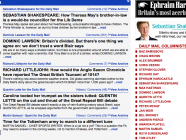Neue Zürcher Zeitung, December 19, 2008
Is the development of the press in the Bay Area a glimpse at what’s in store for journalism?
Anyone who has been away from the Bay Area over the last few years would hardly recognize the newspaper landscape upon return. No other place in the U.S. provides greater indication of the direction journalism is headed for.
Not a single metropolitan area in America prospers more than the region surrounding San Francisco. The average income is higher than anywhere else in the U.S., and it’s possible that no other corner of the world accumulates more wealth. The region is a well educated, colorful, peaceful, multicultural melting pot. One would expect more newspaper readers here than most anywhere.
A wealthy region
The Bay Area’s prosperity is largely derived from technologies that could render old news mediums, like the daily paper, obsolete. Google and Yahoo, Apple and Cisco, Oracle and Sun Microsystems reside in the Silicon Valley. More than seven million people live in this region, in an area half the size of Switzerland. But while Switzerland is still characterized by a unique variety of newspapers, the two most important titles in the Bay Area are struggling to survive.
Just a few years ago, profits were still high. Now, however, Paul Farhi, who observes the media world for the
Washington Post and the
American Journalism Review, has started singing the
“San Francisco News Blues.” He claims: “It is unlikely that any major city newspaper in the country fell more deeply and faster than the
San Jose Mercury News and the
San Francisco Chronicle since the peak of the Dotcom boom seven years ago.”
30 percent loss in circulation
In the past four years, the Chronicle lost 30 percent of its circulation; at present, approximately 370,000 copies are sold daily. In 2000, 575 staff members worked in the editorial office, now there are only 280, thus less than half. In 2007 alone, 100 journalists were let go and in August 2008, the publishing house announced a buyout offer to an additional 125 employees. Like most major city newspapers in the U.S., the Chronicle doesn’t have any foreign correspondents left. The front page nearly presents local news alone. The pages thereafter are almost exclusively contributions of AP and of the news services of the three large papers, the New York Times, the Washington Post and the Los Angeles Times.
Why was it impossible to develop a newspaper culture like New York, Los Angeles or Washington in San Francisco? For decades there was a so-called Joint Operating Agreement that blocked the advancement of the two papers locally. In 1965 the competitors, the San Francisco Examiner and the San Francisco Chronicle, agreed to operate the business side together and to let only the editorial offices compete with one another. For 35 years the profits of both daily papers were divided 50-50. “That wasn’t helpful for either of the newspapers. Maximum quality was surely not the result,” says Phil Bronstein as he looks back. No one can judge better than he: First he was Editor-in-Chief of the Examiner, then, keeping the same position, he switched to the Chronicle from 2003 to the beginning of 2008. Today he works there as the Editor-at-Large and is responsible, among other things, for investigative special projects.
An unfortunate contract
Great hope was linked to the end of the unfortunate contract and the almost simultaneous change of ownership. At the turn of the millennium, Hearst acquired the Chronicle. The paper should have become a world class newspaper. Hearst, however, had a hard time right from the beginning, as an expensive and lengthy lawsuit challenged the takeover. In an unfortunate labor agreement, the media company, which also owned the San Francisco Examiner at this time, made a promise to the trade unions to continue employing all workers from both newspapers. The Examiner was thensold and converted into a free paper.
Hearst had to take on the majority of reporters and editors. Many positions were double and triple-staffed at the Chronicle. “It was a roller coaster ride, ” says Bronstein. Next, the “shake up” on the newspaper markets was added to the mix. Instead of gushing profits, losses began to pile up during the tail-end of the Dotcom boom. Experts estimated losses of more than $ 1 million per week. “The Bay Area is a very innovative region, ” says Bronstein. The full impact of technical innovations, Internet and Web 2.0 would hit “harder and quicker” here. The fact that the Chronicle was surrounded by regional gazettes that belonged to a single media company, the MediaNews Group, had little influence on daily editorial operations. “That is rather a problem for our advertisement department, ” says Bronstein. It has to face up to the MediaNews Group’s overwhelming power. He neglects to mention, however, that poor revenues from advertising have direct consequences on the editorial office’s budget.
City newspaper or metropolitan area paper
Anyone leafing through the paper will sense the indecisiveness, at least within the section concentrating on the Bay Area. Does the Chronicle want to be the city of San Francisco’s paper or the whole region’s paper? What we get is a general store: news from city and region wildly tossed and jumbled. Cynthia Gorney, professor at the Journalism School in Berkeley, recognizes some brilliant individual performances, “for example in the reporting on homeless people or religious topics.” But she criticized the lack of any recognizable “strategy.”
Robert Rosenthal, a former managing editor at the
Chronicle, says the newspaper is inscrutable and unbalanced in its quality. He also sought shelter at Berkeley, where he heads the
Center for Investigative Reporting . The
Chronicle “does good work,” he says, but with everything that goes beyond San Francisco, it is missing breadth and depth. He claims that up until a few years ago the newspaper still had five reporters in Sacramento in order to follow California politics but today there are only “one or two.” If correspondence offices or entire newsrooms shrink to half their staff within a few years, “institutional memory” will be lost and inevitably gaps in the reporting will develop.
Bronstein regards Rosenthal’s judgment as valid: San Francisco is also “inscrutable” as a location and a newspaper must be “unforeseeable,” since it is essential to surprise people. “We tried a lot. Certain things work, others don’t. A newspaper must experiment.” Bronstein stresses that the shrunken editorial office continues to fulfill its role of watchdog. San Francisco Mayor Gavin Newsom complains that the Chronicle investigates “too aggressively,” says Bronstein. Indeed, shortly before the interview, the paper had raised a storm of indignation because it had revealed that the city “protects” under-aged and illegal immigrant drug dealers and other criminals from being deported to their homelands. His new position allows Bronstein to deal with investigative projects in which several of the twelve newspapers belonging to the Hearst company are involved, offering at least some synergies which might strengthen journalism.
The Downslide of the Mercury News
The downslide of the San Jose Mercury News (circulation 235,000) is even more drastic. Even though this former flagship of the second largest U.S. newspaper company, Knight Ridder, didn’t go under with the parent company, two changes of ownership have contributed to the fact that the once-rising regional newspaper, which at the turn of the millennium was still ranked by experts among the Top Ten in America, has degenerated into a cheap local gazette. It’s even occasionally referred to as the “gutter paper.” Under the pressure of investors, Knight Ridder was first purchased for $ 4.5 billion by the smaller competitor, McClatchy, which is also listed on the stock exchange. The new owner immediately resold 12 of the 32 acquired papers. Thus, the San Jose Mercury News ended up at the MediaNews-Group, along with nearly all other gazettes in the Bay Area outside of the city center of San Francisco. This constellation nurtured hopes of fantastic synergy gains among the new owners. Furthermore, right from the beginning Dean Singleton, the CEO of MediaNews, made a “clear decision to keep the profits of his newspapers as high as possible,” says John McManus, a media expert who for many years ran the project “GradetheNews,” which evaluated the regional media in light of their journalistic achievements.
Changed competitive conditions
According to industry analysts, the profit margin in the year 2000 was above 30 percent. But Singleton’s investment becomes a didactic drama that illustrates how changing competitive conditions can ruin even well-established papers if owners with little intuition chase inflated and short-sighted expectations of profit.
It was only a few years ago when the sense of a new era prevailed. When Dan Gillmor began working in the editorial office as a technology reporter in 1994, he felt like he had arrived “in the belly of the beast.” The digital gold rush was in full swing in Silicon Valley. His newspaper contributed to the success; it was considered the source of inside information where the industry turned to when they wanted to find out how the future newspaper would look like.
The editorial office grew. The newspaper could even afford foreign correspondents – though not in London, Rio or Bejing but in Hanoi, in order to provide the large number of Vietnamese immigrants news from their homeland. To expand its reach, Spanish and Vietnamese editions were started. Shortly before the turn of the millennium, many media experts declared the best newspaper in the Bay Area was no longer published in San Francisco, but in its neighboring city, San Jose, in the heart of Silicon Valley. The Mercury News also wanted to expand into San Francisco and opened an office in Union Square. Thus, similar errors were committed as in Germany, when the Süddeutsche Zeitung tried to expand into North Rhine-Westphalia and Die Welt into Bavaria.
Fluff – No Substance
What the Mercury News looks like today is quickly summarized: Content-wise, fluff is given precedence. Supposedly the readers get what they want, as if their brains have shrunk, thanks to the colorful picture orgies that form the newspaper pages and the website alike. Sex and crime, the local and mundane have displaced more important topics. The foreign correspondence office in Vietnam is closed and the paper moved out of San Francisco long ago. The newsroom, which in the best of times employed over 400 journalists, operates with 170 today. This is still a stately number based on European standards, yet such comparisons make little sense because it’ the rigid cutbacks that leave an editorial office bleeding.
Theodore Glasser, journalism professor at Stanford University, thinks the newspaper is “abominable”. His colleague Dawn Garcia, who once worked at the Mercury News as a top editor, considers cancelling her subscription to the paper as it’s become superfluous. But she hasn’t completely made up her mind: “I grew up here. And I read the obituaries!” she says with dark humor. “Now, the best is the home and garden supplement.”
Translated by Karin Eberhardt












































